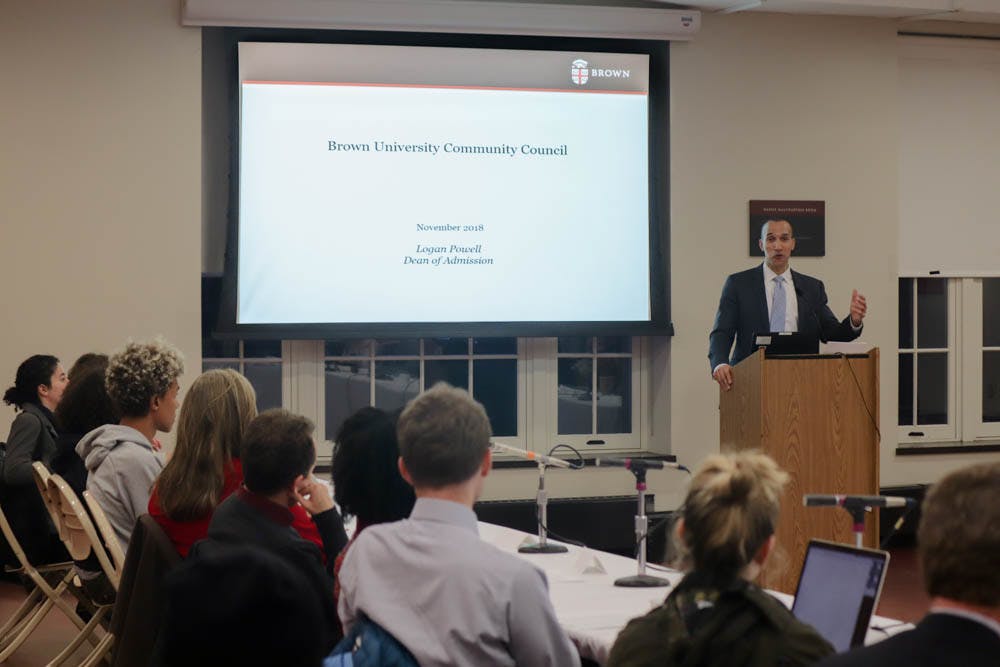Dean of Admission Logan Powell presented statistics on the early decision applicants for the class of 2023 in light of the University’s Nov. 1 deadline at yesterday’s Brown University Community Council meeting.
Many trends are “beginning to take place because of Brown Promise,” an initiative to replace student loans with grants in University financial aid packages, Powell said. For example, the University saw a “staggering” 20 percent increase in the volume of early decision applicants, from 3,501 for the class of 2022 to 4,169 for the class of 2023. The number of early applicants who indicated an interest in applying for financial aid also increased by 11 percent over last year, which Powell said is “exactly what we hoped to see.”
The Brown Promise might make the University “more attractive to students and families from parts of the country we wanted to see more of,” like the Midwest, Powell said. In fact, the University saw a 43 percent increase in early applications from the Midwest from last year. Powell stressed that policy changes like the Brown Promise are made because “(they’re) the right thing to do,” rather than attempts to drive up application volume. Nevertheless, changes in the University’s financial aid policy have historically spiked growth in applications. According to Powell, “when we announced we were need blind, we had our first real surge in applications.”
The class of 2023 “is actually the first cohort of applicants we’ve seen since some pretty large policy shifts,” Powell said. Recently, the University doubled travel grants for low-income students to visit campus during the prospective student program A Day on College Hill, The Herald previously reported. Students who visit campus are twice as likely to commit to Brown as those who don’t, Powell added. This year, the University saw a 33 percent total increase in the number of students who visited during ADOCH, likely due to this increase in accessibility for low-income students, Powell said.
In years past, the University didn’t “have the funds available to actually invite every low-income admitted student” to campus for ADOCH, Powell said. “In some cases, we had multiple low-income students admitted from the same high school and we had been selecting one or two out of three or four of them — and that was just heartbreaking to me, we shouldn’t have been doing that.”
Other recent policy changes include hosting ADOCH on two separate weekends rather than one, waiving application fees for low-income students, creating a financial aid brochure, creating a new admission website, paying tour guides and creating a working group on access for first-generation and low-income students.
At the meeting, Powell and President Christina Paxson P’19 also discussed the lawsuit between Harvard and Students for Fair Admissions regarding affirmative action procedures. “Brown has been very clear in its firm support for the use of holistic admissions in which race is one of many factors that’s used for deciding whether to offer an applicant admission to Brown,” Paxson said.
“When we admit a student to Brown, we’re looking at the whole person. We’re looking at their background, their experience, their test scores, whether they come from a rural area, an urban area, whether they play the tuba,” Paxson said. “We’ve rejected pretty strongly the idea that applications should be censored in a way that removes something that is actually a really important part of their backgrounds and their experience,” she added.
Following Powell’s presentation, Executive Director of the Office of Industry Engagement and Commercial Venturing Daniel Behr took the podium to highlight the office’s work in its first year at the University. The mission of the office is “unleashing the impact of Brown’s research,” Behr said. “Universities are terrific at educating and research, but their business model doesn’t include thinking commercially,” he added. The office will work to commercialize innovations “from the lab to the marketplace.” While many peer institutions such as Penn and Harvard have $800 million to $1 billion dollar research funds, the University sits in the $150 to $200 million range. Behr hopes the University will some day value “rare, unpredictable, highly desirable unicorns” like the billion dollar drugs that can generate universities a lot of revenue.





